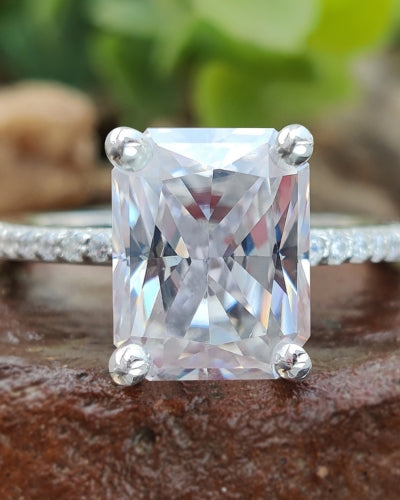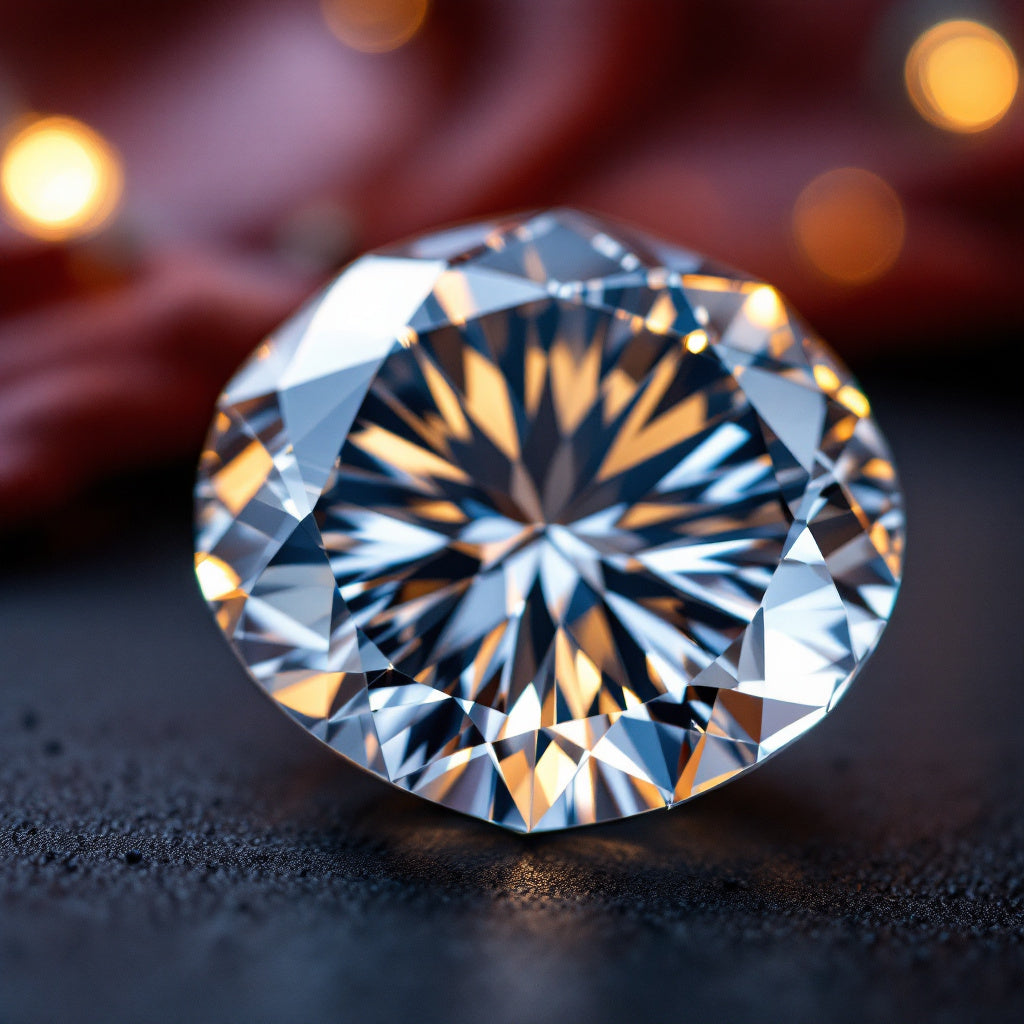The Science Behind Lab-Grown Diamonds: A Sparkling Revolution
Diamonds have long captivated humanity with their brilliance, durability, and rarity. Traditionally mined from deep within the Earth’s crust, diamonds are now being created in laboratories with cutting-edge technology that replicates—and even enhances—the natural process. Lab-grown diamonds are chemically, physically, and optically identical to their mined counterparts, but their creation is a fascinating blend of science, engineering, and innovation. In this blog, we’ll explore the science behind lab-grown diamonds, how they’re made, and why they’re reshaping the jewelry industry.

What Are Lab-Grown Diamonds?
Lab-grown diamonds, also known as synthetic, man-made, or cultured diamonds, are diamonds produced in controlled laboratory environments rather than extracted from the Earth. Unlike diamond simulants like cubic zirconia or moissanite, which merely mimic the appearance of diamonds, lab-grown diamonds are true diamonds. They share the same crystal structure, chemical composition (pure carbon), and physical properties as natural diamonds, including their unmatched hardness (10 on the Mohs scale) and dazzling sparkle.
The key difference? Lab-grown diamonds are created in weeks or months, not billions of years. This efficiency, combined with ethical and environmental benefits, has made them increasingly popular among consumers and jewelers alike.
How Are Lab-Grown Diamonds Made?
The creation of lab-grown diamonds involves replicating the extreme conditions under which natural diamonds form deep within the Earth’s mantle—high temperatures and immense pressures. Scientists have developed two primary methods to achieve this: High-Pressure High-Temperature (HPHT) and Chemical Vapor Deposition (CVD). Let’s dive into the science behind each.
1. High-Pressure High-Temperature (HPHT)
The HPHT method mimics the natural diamond-forming environment found 100-150 kilometers below the Earth’s surface. Here’s how it works:
- The Setup: A small diamond “seed” (a tiny fragment of an existing diamond) is placed in a specialized press capable of generating pressures up to 5-6 gigapascals (roughly 50,000 times atmospheric pressure) and temperatures exceeding 1,400°C (2,550°F).
- Carbon Source: A carbon-rich material, typically graphite, is introduced into the chamber. Graphite is the same form of carbon found in pencil lead, but under extreme conditions, it transforms into diamond.
- The Process: The press applies intense heat and pressure, causing the graphite to dissolve into a molten metal catalyst (often iron, nickel, or cobalt). The carbon atoms migrate toward the diamond seed, where they bond layer by layer, forming a larger diamond crystal.
- The Result: After days or weeks, the press is cooled, and a rough diamond crystal is extracted. These diamonds often have a yellowish tint due to nitrogen impurities but can be treated to achieve colorless or near-colorless grades.
HPHT diamonds were the first lab-grown diamonds, pioneered in the 1950s by General Electric for industrial purposes. Today, refinements in the process produce gem-quality diamonds rivaling the finest mined stones.

2. Chemical Vapor Deposition (CVD)
The CVD method is a more recent innovation, offering greater control over the diamond’s properties. Instead of crushing carbon into a diamond, CVD grows diamonds atom by atom in a vacuum chamber. Here’s the breakdown:
- The Setup: A diamond seed is placed in a sealed chamber filled with a carbon-rich gas, typically methane (CH₄), mixed with hydrogen.
- The Process: The chamber is heated to around 800-1,200°C (1,470-2,190°F), and a microwave or plasma source energizes the gas, breaking it into reactive particles. Carbon atoms separate from the methane and deposit onto the diamond seed, forming a thin layer of diamond. This process repeats, building the crystal layer by layer.
- The Result: Over weeks, the seed grows into a diamond plate, which is cut and polished into a gemstone. CVD diamonds are often purer than HPHT diamonds, with fewer inclusions, and can be produced in larger sizes.
CVD’s precision allows for unique applications, like creating diamonds for electronics or colored diamonds (by introducing specific gases like nitrogen for yellow or boron for blue).
The Science of Diamond Perfection
Both HPHT and CVD rely on the unique properties of carbon and its ability to form a diamond’s crystal lattice—a three-dimensional structure where each carbon atom bonds covalently with four others in a tetrahedral arrangement. This lattice gives diamonds their extraordinary strength, thermal conductivity, and optical brilliance.
To ensure gem-quality results, lab-grown diamonds undergo rigorous quality control:
- Purity: Nitrogen, boron, or metal inclusions can affect clarity and color. Advanced techniques minimize these impurities.
- Cut and Polish: Like mined diamonds, lab-grown diamonds are cut and polished to maximize their fire (color dispersion) and brilliance (light reflection).
- Grading: Independent gemological institutes, like the Gemological Institute of America (GIA), grade lab-grown diamonds using the same “Four Cs” (cut, color, clarity, carat) as natural diamonds. Reports often note their lab-grown origin for transparency.
Why Lab-Grown Diamonds Matter
The science behind lab-grown diamonds isn’t just a technical marvel—it’s driving a revolution in the diamond industry. Here’s why:
1. Ethical and Environmental Benefits
Mined diamonds often come with ethical concerns, including conflict financing and labor exploitation, as well as environmental costs like deforestation and water usage. Lab-grown diamonds bypass these issues. They require less land disruption and have a smaller carbon footprint, especially when produced with renewable energy.
2. Affordability
Lab-grown diamonds are typically 20-40% less expensive than mined diamonds of comparable quality. This affordability allows consumers to purchase larger or higher-quality stones within their budget.
3. Versatility
Beyond jewelry, lab-grown diamonds are transforming industries. Their hardness makes them ideal for cutting tools, while their thermal conductivity suits them for electronics. Scientists are even exploring diamond-based quantum computers.
4. Customization
CVD technology, in particular, allows for tailored diamond production. Want a pink diamond for an engagement ring or a diamond wafer for a tech application? Labs can make it happen.
Debunking Myths About Lab-Grown Diamonds
Despite their rise, lab-grown diamonds face misconceptions. Let’s clear up a few:
- Myth: They’re “fake” diamonds. Reality: Lab-grown diamonds are 100% real diamonds, indistinguishable from mined ones without specialized equipment.
- Myth: They’re low quality. Reality: Many lab-grown diamonds achieve top grades for clarity and color, often surpassing mined diamonds.
- Myth: They have no value. Reality: While resale value may differ, their beauty, durability, and ethical appeal hold significant worth for buyers.
The Future of Lab-Grown Diamonds
As technology advances, lab-grown diamonds are poised to grow in popularity. Innovations in HPHT and CVD are reducing costs and increasing production capacity. Researchers are also experimenting with new methods, like laser-assisted growth, to push the boundaries of what’s possible.
Consumer demand is another driver. Millennials and Gen Z, who prioritize sustainability and transparency, are embracing lab-grown diamonds for engagement rings, earrings, and more. Jewelers like Pandora and De Beers are expanding their lab-grown offerings, signaling a shift in the market.

Conclusion
The science behind lab-grown diamonds is a testament to human ingenuity. By harnessing extreme pressures, scorching temperatures, and atomic precision, we’ve unlocked a way to create nature’s hardest substance in a lab. These diamonds aren’t just beautiful—they’re ethical, affordable, and versatile, offering a sustainable alternative to mined gems without compromising quality.
Whether you’re drawn to their sparkle, their story, or their science, lab-grown diamonds prove that brilliance can be engineered. As technology continues to evolve, one thing is clear: the future of diamonds is bright, and it’s being shaped in the lab.










Dejar un comentario
Este sitio está protegido por hCaptcha y se aplican la Política de privacidad de hCaptcha y los Términos del servicio.